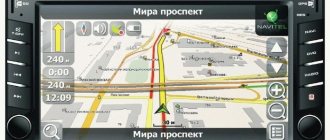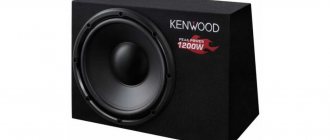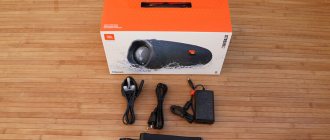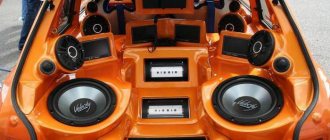What is a monoblock?
This term refers to a single-channel amplifier. It has unique parameters. In general, such a device is similar in principle to multi-channel models. However, the use of the prefix “mono” indicates that this device is considered single-channel.
Single channel amplifier
This term is called a monoblock. A single-channel amplifier is considered the simplest type. This device is used when a subwoofer is connected. It comes in 2 classes – AB and D.
At the same time, the monoblock, which belongs to class D, operates with a 1 Ohm winding and with 2 and 4 Ohm subwoofers. That is why it is chosen more often than an AB class monoblock. The use of a device with a low load of 1 ohm makes it possible to obtain high signal power with a small load on the battery.
What is an amplifier?
This device helps amplify sound frequencies. This effect is achieved by enhancing electrical vibrations. There are several classes of such devices - A, B, AB and D. The main criteria for division are efficiency and distortion of sound signals. So, the characteristics of the listed classes include the following:
- A - such devices help achieve maximum sound quality with minimal distortion. These devices are used for expensive acoustic systems that belong to the elite class. The main disadvantage of the products is considered to be low efficiency, which does not exceed 20-25%. In this case, the signal loses its power. In practice, such devices are used extremely rarely. This is due to the high cost and imperfect technical parameters.
- B - these devices are characterized by more efficient power than in class A. However, they are inferior in terms of distortion. Since the reproduced signal is characterized by insufficient “purity”, this class is also used quite rarely to create acoustic stereo systems.
- AB is the most common and popular class. It is characterized by average sound quality, high signal power and clear sound, which is ensured by a low level of distortion. At the same time, the efficiency parameters are at the level of 45-50%. Devices of this class are medium-priced and large in size. This option can be used for subwoofers with a power of 500-600 watts.
- D – such devices are used for processing digital signals. They are characterized by compact dimensions and high power. Distinctive features also include low sound quality and a low level of distortion. Class D devices have a maximum efficiency level of 90-98%. These devices do not have a cooling radiator because they hardly heat up. Such devices are characterized by high cost, which is why they are usually not used by audiophiles or car enthusiasts.
Two channel amplifiers
Such devices are characterized by a more complex structure than single-channel amplifiers. They allow you to connect 2 speakers or 1 passive subwoofer. It helps maintain a low load of 1-2 ohms.
The device operates exclusively using a bridge connection. This type of device also supports additional functions. Among them, the most common option is the possibility of gradually enhancing the parameters of low frequencies.
Four channel amplifiers
This type of device is considered the most popular. Its design includes 2 two-channel amplifiers, which are built into one housing. Therefore, the capabilities of the device coincide with an amplifier having 2 channels. The main purpose is to increase the power of the front or rear acoustic stage.
The four-channel device is designed for low power - 50-100 watts per channel. This helps to connect 4 speakers or 2 subwoofers.
Five-channel amplifiers
Such devices are used to simultaneously connect 4 speakers and one subwoofer. For this, a mono channel is used.
Six-channel amplifiers
This device is considered the most expensive and provides a wide range of possible options for connecting different acoustic elements. These include:
- 6 speakers;
- 1 subwoofer, which is a bridge connection, and 4 speakers;
- 3 subwoofers.
What you need to know about audio amplifiers?
With the help of this device, the electrical signal is transformed, becoming more powerful and pure. In this case, there should be no distortion at the input. The device can be stand-alone or part of other, more complex ones - televisions, stereo systems, radios. If the equipment is purchased separately, it is important that it is compatible with other converters - headphones, speakers, stereo system.
Choosing an amplifier can be difficult, especially if it is purchased online and there is no way to check the sound quality. Therefore, when ordering, you should pay attention to many aspects. First of all, decide on the purpose of the device.
What types of sound amplifiers on Aliexpress can be found in the catalog?
On the site you can find devices for various purposes: professional and for home use, models for cars. The last two types are the most in demand, while complex equipment is needed only by a small category of users.
What parameters should you look at if you need to buy an amplifier through an online store?
First of all, pay attention to the output power. You should not think that the larger it is, the better. The parameters must correspond to the area of the room in which the sound system will be used. Resistance indicators are also important, the speaker range should be in an even range from 2 to 16 Ohms, with large values there is a risk of device failure. Another factor is frequency response and dynamic qualities.
Can you save money by purchasing an older model?
This way you can win money, but it is worth remembering that equipment lying in storage may not be able to reproduce sound of adequate quality. In addition, terminals and current conductors may oxidize from long-term storage. Since it is impossible to pre-check the condition when ordering via the Internet, it is better to choose, if not new items, then devices that have been released recently.
If in doubt, it would be a good idea to look at the reviews of other customers - with their help you can find out the nuances that are not indicated in the technical characteristics section. For example, if the output voltage of a device is indicated as 200V, a review of reviews shows that this is not always true. Also, when ordering, do not neglect the seller's rating.
Differences between an amplifier and a monoblock
The differences between the devices in question cover many aspects. In essence, a monoblock is the same amplifier, but it is characterized by certain features. As the name suggests, the device is equipped with a single channel.
Unlike other types of devices, monoblocks are used to connect subwoofers and enhance the bass of low frequencies. That’s why single-channel products are also called bass products.
Monoblocks are designed for low-resistance loads. It does not exceed 1 Ohm. Compliance with this rule allows you to obtain high output power with minimal load on the car's electrical network. It is not advisable to buy low-frequency devices for 2 and 4 Ohms.
Speakers and other types of amplifiers are not connected to the monoblock if there are a sufficient number of channels. This makes it possible to combine the connection of speakers and subwoofers.
According to the classification of electric amplifiers, monoblocks today often belong to class D. This means that they are characterized by high power and not very good sound quality. When connecting a subwoofer, sound quality is considered an insignificant parameter. The remaining budget devices belong to class AB, which is characterized by average parameters. There is also class A, which is distinguished by high-quality sound and low power.
Functionality
A regular amplifier works with a 4-ohm speaker, but it can also handle 2-ohm ones. In this case, you need to connect a 4 Ohm subwoofer. This is done in bridge mode. For a subwoofer amplifier, stable operation with a resistance of 1 Ohm is important. Brief operation at 0.5 Ohm is also possible. Functionally, many bass amplifiers feature a non-switchable low-pass filter (LP).
Expert opinion
Karnaukh Ekaterina Vladimirovna
Graduated from the National University of Shipbuilding, majoring in Enterprise Economics
Subsonic is considered a mandatory element of devices. It must be present if the subwoofer is mounted in a bass reflex enclosure. This element is considered a subtonal filter. Also, in many cases it is not possible to do without Bass Boost. This element is required when changing the noise field in a car.
Another functional feature of such devices is the phase regulator. It is quite rare in monoblocks. However, this element is often present in bass amplifiers.
Line inputs are present in any amplifier, while high-level inputs are not always required. They are needed for a small upgrade of the standard audio system.
Application
Many car stereo systems already include a built-in multi-channel amplifier. For most drivers, this system is completely suitable. Many people do not change the standard sound in their car for years. However, there are many motorists who want to get high-quality and loud sound in their car.
In such a situation, amplifiers are required. A car subwoofer will not give the desired effect. At the same time, the use of special amplifiers will help improve acoustic parameters, regardless of the quality of the main unit.
A car subwoofer amplifier, which is present as part of the speaker system, provides several important advantages. It helps increase the power of sound and make it better.
Most often, car acoustics are purchased after installing the main unit. If the speakers and subwoofer are of high quality, they will need more power for maximum performance. Standard radio does not provide this effect. Therefore, you need to buy separate car devices to amplify the sound. You should choose a specific model based on your personal preferences and budget.
Price
The price of the devices in question differs significantly. The most affordable is considered a monoblock or single-channel device. It can be bought for 4000-6000 rubles. The specific price depends on the model and class of the device.
Six-channel devices are considered the most expensive. At the same time, there are many models on sale that differ in quality sound characteristics. The price of such devices ranges from 17,000-37,000 rubles. The cost is influenced by many parameters - brand, quality characteristics, class.
AIYIMA 100W Mono Power Amplifier Board
The manufacture of the body began with the fact that it was assembled from scrap materials, an available hand-held circular saw (Hitachi C6SS), and a sawing table, simple, but quite suitable for my needs.
Since after making the table there was 21mm plywood left (actually 19mm), it was decided to use some of it to make a small case for the TPA3116 amplifier. The main inspiration for the cabinet idea was amplifiers from PEACHTREE AUDIO
I like products made from end-cut plywood, so I decided to do it as follows. Slats with a height of 15 mm were sawn from plywood on a sawing table (respectively, the cut thickness of the plywood was 19 mm). Three plates were assembled from plywood slats, with the end cuts facing upwards, two large ones for the lower and upper parts of the body, and one smaller one, from which two side ones would be made walls. I applied glue to each rail and pressed it with clamps. I also clamped the resulting plate between two boards from below and above, so that the slats under the clamps did not go in an arc.
I trimmed the resulting plates on a sawing table, and sawed out the side walls from a smaller plate. Next, we glue the box from the top, bottom and side plates and tighten them with clamps.
Since the joints of all four parts should not be visible on the front part of the case, I decided to make the front edging part of the front panel from plywood 6 mm thick. I made a drawing of the front panel, printed it out, cut it out, transferred it using a pencil to the plywood according to the template, and cut out the inner window with a hand router (Bosch POF 1200)
Next, I glued the resulting part to the front of the box. I took the case, took an angle grinder with a Velcro attachment for grinding wheels (60 grit), went outside, drew radii on the corners of the box, and removed the excess material with a grinding wheel. You have to do it carefully, because it’s easy to dive in with your hand and remove the excess, then it’s hard to correct it, increase the radii, and then the thickness of the plates won’t be enough. This, of course, can be done with a router, but it’s somehow not profitable to buy a milling cutter for four passes.
We also trim the front aluminum panel (4 mm thick) on a sawing table, round the corners of the angle grinder, finish it with a Dremel, push it into the edging part so that it fits tightly. Since our edging part is 6 mm, the aluminum panel fits in with a recess of 2 mm, then what do you need.
We drill a hole in the aluminum panel for the power button and for the amplifier volume potentiometer. Since the aluminum panel was mirrored, it was necessary to make it in the “brushed aluminum” style. Place the plate relative to the parallel stop in a static position (double tape works well). We take a small wooden block slightly larger than the width of the panel, wrap it with sandpaper (80-120 grain), and fasten the sandpaper firmly on top of the block with an emery stapler. We also apply one side of the block to the parallel stop and, with equal pressure, move the block along the plate strictly in one direction without shifting left or right, otherwise inclined lines will appear. You need to make 20-30 such passes, making sure that the color is uniform and the degree of sanding is the same.
The back panel was made from a 5 mm foamed PVC sheet (an old advertising poster, also used as a covering for the sawing table). The recess for the rear panel was made directly in the case, using a router, although it was a little sloppy, since everything is suspended, not very convenient, but not scary either, only in the back I know that there are jambs there.
I cut out the PVC sheet with a knife and drilled holes for the power terminal, RCA and BANANA connectors (taken from an old SVEN-620 subwoofer), and also placed a toggle switch for inputs. Drilled ventilation holes. Afterwards I painted the back panel with black paint and installed all the elements.
We sand the entire plywood body for a long time, achieving a smooth surface so that transitions between the glued slats, if any, are not felt. Then everything is covered with oil. I used BELINKA Interier oil. In several layers over two days. Then polish with a wool wheel until shiny.
We install an amplifier inside, a power supply (from some laptop, 4A, 19V), install the panels and install the potentiometer knob. The feet at the bottom of the amplifier are rubber, with an adhesive backing, purchased from furniture fittings in Leroy Merlin.
In principle, everything, the body is ready.
conclusions
The devices in question have many differences. At the same time, it is difficult to say unequivocally which device is better. To understand the differences between devices, it is worth considering the following:
- The monoblock helps enhance the bass.
- A monoblock is a single-channel device. At the same time, the remaining amplifiers have up to 6 connection channels.
- The main parameter of a monoblock is the input power. For an amplifier, sound quality is especially important.
- Amplifier class is A or AB. Monoblocks are often classified as class D.
- A subwoofer or speakers are connected to the amplifier. Only a subwoofer can be connected to the monoblock.
It is also worth considering that for 2 or 4 Ohms it is considered inappropriate to buy low-frequency amplifiers. If the device has a sufficient number of channels, it is possible to combine the connection of speakers and subwoofers.











